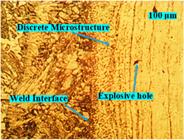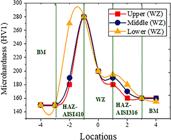ABSTRACT
The mechanical and metallurgical properties of the AISI 316/AISI 410 stainless steel junctions are examined in this study employing TIG welding. The microstructural properties of the welds were examined, and their effects on joint integrity were evaluated by exposing them to different welding conditions. Strength-loving AISI 410 stainless steel and corrosion-resistant AISI 316 stainless steel were butt connected and put through various tests. The complicated interplay between alloy compositions and welding conditions was highlighted by the results, which showed significant differences in both mechanical strength and microstructure. The purpose of this study is to shed light on how best to weld different types of stainless steel alloys together. Experiments using TIG welding with varying current flows, welding speeds, and shielding gas flow rates were conducted to achieve this. The optimal method settings were determined by taking into account responses such as micro hardness and tensile strength. Their effects had been ascertained through the use of analysis of variance. Based on the GRA, the optimal set of settings was determined to be 120 amp welding current, 2 m/min welding speed, and 10 lit/min shielding gas flow.
Keywords:
Grey relational analysis; Torch speed; Electrode apex; Welding current; Welding voltage; Shielding gas

 Exploration of TIG welding's impact on the structural integrity and metallographic characteristics of AISI 316/AISI 410 stainless steel joints
Exploration of TIG welding's impact on the structural integrity and metallographic characteristics of AISI 316/AISI 410 stainless steel joints Thumbnail
Thumbnail
 Thumbnail
Thumbnail
 Thumbnail
Thumbnail
 Thumbnail
Thumbnail
 Thumbnail
Thumbnail
 Thumbnail
Thumbnail
 Thumbnail
Thumbnail
 Thumbnail
Thumbnail








